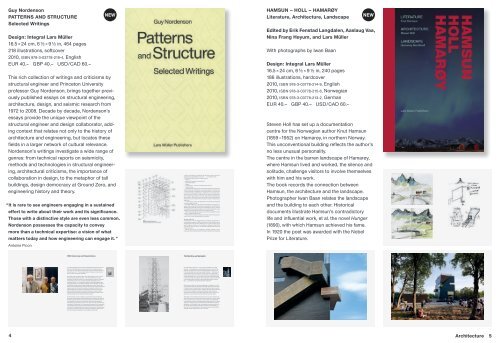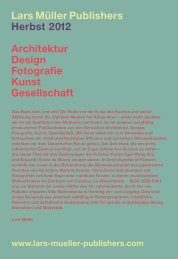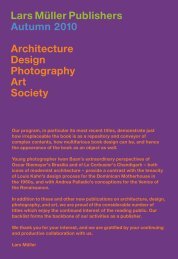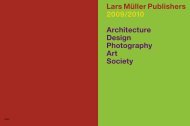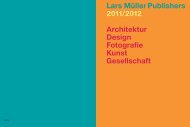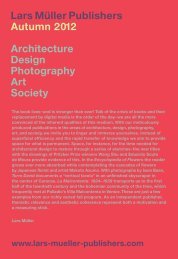Lars Müller Publishers 2010/2011 Architecture Design Photography ...
Lars Müller Publishers 2010/2011 Architecture Design Photography ...
Lars Müller Publishers 2010/2011 Architecture Design Photography ...
Create successful ePaper yourself
Turn your PDF publications into a flip-book with our unique Google optimized e-Paper software.
guy nordenson<br />
PATTErnS AnD STruCTurE<br />
Selected writings<br />
<strong>Design</strong>: Integral <strong>Lars</strong> <strong>Müller</strong><br />
16.5 × 24 cm, 6 ½ × 9 ½ in, 464 pages<br />
218 illustrations, softcover<br />
<strong>2010</strong>, ISBN 978-3-03778-219-4, English<br />
EUR 40.– GBP 40.– USD / CAD 60.–<br />
nEw<br />
This rich collection of writings and criticisms by<br />
structural engineer and Princeton University<br />
professor Guy Nordenson, brings together previously<br />
published essays on structural engineering,<br />
architecture, design, and seismic research from<br />
1972 to 2008. Decade by decade, Nordenson’s<br />
essays provide the unique viewpoint of the<br />
struc tural engineer and design collaborator, adding<br />
context that relates not only to the history of<br />
architecture and engineering, but locates these<br />
fields in a larger network of cultural relevance.<br />
Nordenson’s writings investigate a wide range of<br />
genres: from technical reports on seismicity,<br />
methods and technologies in structural engineering,<br />
architectural criticisms, the importance of<br />
collaboration in design, to the metaphor of tall<br />
buildings, design democracy at Ground Zero, and<br />
engineering history and theory.<br />
“ It is rare to see engineers engaging in a sustained<br />
effort to write about their work and its significance.<br />
Those with a distinctive style are even less common.<br />
nordenson possesses the capacity to convey<br />
more than a technical expertise: a vision of what<br />
matters today and how engineering can engage it. ”<br />
Antoine Picon<br />
With Great Joy and Expectations<br />
In his 1968 autobiography Isamu Noguchi quoted Marcel Duchamp’s advice to him:<br />
“ Don’t do anything that pleases you — only do that which you dislike and cannot<br />
help but do. This is the way to find yourself. But it is also true that we cannot ever<br />
be more than we are.” This turns against the grain of desire, but does not deny<br />
desire or passion. It stills and sublimates it.<br />
Buckminster Fuller and Isamu Noguchi met at Romany Marie’s tavern, for which<br />
we are told Bucky designed the décor. Fuller would often stand on a table<br />
and declaim his Homeric account of four-dimensional science and art, of triangles<br />
and tetrahedra and the “ new consciously disciplined relationship of man to<br />
his physical universe.” He enchanted an audience that included Noguchi, Mark<br />
Tobey, Willem de Kooning, The Museum of Modern Art’s Dorothy Miller, the paleontologist<br />
Walter Granger, and even Vilhjálmur Stefánsson, the Arctic explorer, with<br />
epics that were part mathematics, part physics and chemistry, and part neo-Buddhist<br />
mysticism avant-la-lettre, “ what the scientist-artist speaks of as intuition is the<br />
intellect-initiated and synergetically precessional event evolution into conscious<br />
objective anticipatory evolutionary conceptual formulation, realized in thought<br />
described words, mathematical relationship rotation, graphical schematics, threedimensional<br />
static and four-dimensional kinetic modelling.”<br />
In 197 6 I worked as an intern in Noguchi’s Long Island City studio for Fuller and<br />
Shoji Sadao, making tensegrity models with Rob Grip, one of Bucky’s assistants, for<br />
that fall’s inaugural exhibition at the Cooper Hewitt Museum, titled Man Transforms.<br />
Fuller stopped by one day and took me aside for tête-à-tête in his and Sadao’s<br />
drafting office. He sat perched on a table; I took a chair, he turned off his hearing aid<br />
and started off. Unfortunately, I don’t remember what he spoke of, but I do remember<br />
I said nothing, figuring he could not or did not want to hear. Twenty-five years later<br />
I learned from his daughter Allegra Fuller Snyder that he would turn off his hearing aid<br />
at the start of a conversation so that he would not be distracted by ambient noises<br />
and could concentrate, reading lips. I had completely misunderstood.<br />
2. Boiler wall stiffness is neglected and the boiler element masses are<br />
apportioned to each platform or key level on a tributary basis.<br />
3. Typical load paths for boiler inertial loads are:<br />
– element<br />
– boiler wall ( consisting of vertical tubes )<br />
– horizontal buckstay<br />
– bumper<br />
– main structure — columns or horizontal key level truss<br />
– vertical bracing<br />
Considerable attention is given to the design of the boiler wall to bumper<br />
portion of the path, including any stress concentrations in the boiler wall.<br />
4. Vertical bracing is designed by conventional means. A critical factor<br />
is usually the client-specified limit on uplift forces at the column bases.<br />
Current practice has been to mitigate this by locating the bracing between<br />
columns supporting the “ top steel ” plate girders, mobilizing their<br />
large reactions. The necessity for numerous ducts and other penetrations<br />
across these “ inner ” bents, however, sometimes results in awkward configurations.<br />
A review of this practice has identified several drawbacks which this<br />
study has sought to correct:<br />
– The boiler stiffness is in fact large and will influence the dynamic response<br />
of the overall system. This has been recognized in the 1988 Uniform<br />
Building Code (1988 UBC ) provisions for nonbuilding structures, wherein<br />
it is mandated that elements weighing over 25 percent of the total system<br />
weight must be properly represented in the analytical model.<br />
– The horizontal diaphragm structure of two trusses alongside the boiler<br />
cannot be considered rigid overall.<br />
– The interference of ducts and other penetration with the bracing at the<br />
“ inner ” bents is costly and preferably to be avoided.<br />
Literature Review<br />
An exhaustive review of existing literature on both the analysis and actual<br />
earthquake response of SBSs has been done. Selected references are<br />
provided herein. The literature obtained covers a range of topics including<br />
the behavior of boilers in real earthquakes, vibration testing of fullsize<br />
and scale model structures, and dynamic modelling of the boiler and<br />
support structure.<br />
Damage observed in real earthquakes includes buckling of crossbracing,<br />
permanent deformations of the bumpers, damage caused by piping<br />
Tall Building as Metaphor<br />
“ The ‘ tall buildings, ’ which have . . . usurped a glory that affects you as rather<br />
surprised, . . . the multitudinous sky-scrapers standing up to the view, from the<br />
water, like extravagant pins in a cushion already overplanted, and stuck in as<br />
in the dark, anywhere and anyhow, have at least the felicity . . . of taking the sun<br />
and the shade in the manner of towers of marble. They are not all of marble,<br />
I believe, by any means, even if some may be, but they are impudently new and<br />
still more impudently ‘ novel ’ — this in common with so many other terrible things<br />
in America — and they are triumphant payers of dividends; all of which, with flash<br />
of innumerable windows and flicker of subordinate gilt attributions, is like the<br />
flare, . . . of the lamps of some general permanent ‘ celebration.’ ”<br />
After the terrorist attacks on New York and Washington on September 11 , 2001,<br />
it was natural to wonder why the World Trade Center Towers and not the Statue<br />
of Liberty had been the target in New York, why Al Qaeda had chosen a symbol<br />
of commerce over a symbol of freedom. Whatever the answer, there is little doubt<br />
that if it had been attacked, the statue would have been rebuilt ( as was the<br />
Pentagon ) and not replaced ( as the World Trade Center will be ). What is not as<br />
clear is how it would have been rebuilt, and what that would have meant.<br />
Tall buildings, if only by being tall, look to stand out in a crowd. In time they may<br />
become the crowd, but it is always their intention to speak up, to declare, indeed,<br />
even to persuade us of their novelty, their sumptuousness, their responsibility<br />
to social needs and ideals, their outright beauty, and their abstraction. The World<br />
Trade Center Towers were built to revitalize downtown Manhattan and promote<br />
globalization. Like Rockefeller Center, they expressed a unique moment of civic<br />
will. And they became exponents of global commerce in the marketplace of<br />
New York City. After their destruction, the same expression of civic will did not<br />
reemerge; what did emerge was more of our own time.<br />
hAMSun – hOLL – hAMArøy<br />
Literature, <strong>Architecture</strong>, Landscape<br />
Edited by Erik fenstad Langdalen, Aaslaug Vaa,<br />
nina frang høyum, and <strong>Lars</strong> <strong>Müller</strong><br />
With photographs by Iwan Baan<br />
<strong>Design</strong>: Integral <strong>Lars</strong> <strong>Müller</strong><br />
16.5 × 24 cm, 6 ½ × 9 ½ in, 240 pages<br />
186 illustrations, hardcover<br />
<strong>2010</strong>, ISBN 978-3-03778-214-9, English<br />
<strong>2010</strong>, ISBN 978-3-03778-215-6, Norwegian<br />
<strong>2010</strong>, ISBN 978-3-03778-213-2, German<br />
EUR 40.– GBP 40.– USD / CAD 60.–<br />
Steven Holl has set up a documentation<br />
centre for the Norwegian author Knut Hamsun<br />
(1859 –1952) on Hamarøy, in northern Norway.<br />
This unconventional building reflects the author’s<br />
no less unusual personality.<br />
The centre in the barren landscape of Hamarøy,<br />
where Hamsun lived and worked, the silence and<br />
solitude, challenge visitors to involve themselves<br />
with him and his work.<br />
The book records the connection between<br />
Hamsun, the architecture and the landscape.<br />
Photographer Iwan Baan relates the landscape<br />
and the building to each other. Historical<br />
documents illustrate Hamsun’s contradictory<br />
life and influential work, et al. the novel Hunger<br />
(1890), with which Hamsun achieved his fame.<br />
In 1920 the poet was awarded with the Nobel<br />
Prize for Literature.<br />
4 <strong>Architecture</strong> 5<br />
nEw


